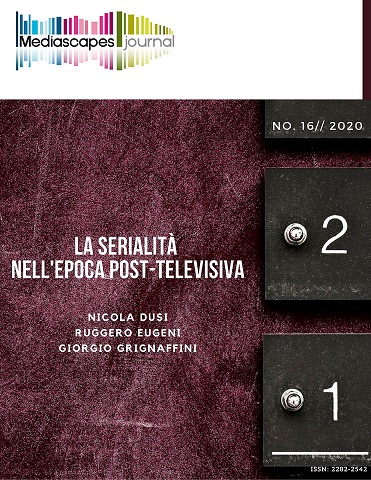Tv playlist: serie tv, musica e supervisione musicale
Keywords:
music supervisor, tv series, compilation score, television, songsAbstract
The essay focuses - within a semiotic methodological setting - on the role of music within the TV series in recent years, starting with a comparing with Seventies. That television sound universe - including commercials - constituted a sort of world apart with respect to the music heard on the radio in that same period. An historical disjunction between music and television which seems to change coinciding with the mid-eighties. In this regard the innovative example of the Miami Vice series is here mentioned, and a crucial role seems having been played also by the advent of music videos and the MTV network. An influence felt both in television and in cinema, with a new relevance acquired by compilation scores, that is, only composed of pop songs (think of the Q. Tarantino case), or in any case of non-original compositions. A significantly different role of music in the TV series appeared with the "The OC" case: a series where music was not meant to have only an underscore function but it should have being an essential element of the storytelling process. The choice of Alexandra Patsavas as musical supervisor marked a change in the relevance of this productive role. Usually music supervisor has the task of finding the suitable songs to compose the soundtrack of an audiovisual. A role involving taste and legal skills, but which in recent years is also crucial in the creation of television storytelling. For this purpose, a case analysis of some sequences of the "Better Call Saul" series is proposed here. In addition, some examples of contemporary use of music in the TV series are treated, relating for instance to the use of diegetic music (music belonging to the fictional world of characters) and to the use of compilation scores coming from past soundtracks, as is the case of the "Homecoming" series.
Downloads
Published
How to Cite
Issue
Section
License
Mediascapes Journal is published under a Creative Commons Attribution Licence 4.0.
With the licence CC-BY, authors retain the copyright, allowing anyone to download, reuse, re-print, modify, distribute and/or copy their contribution. The work must be properly attributed to its author. It should be also mentioned that the work has been first published by the journal Anuac.
Having published these contributions for the first time, Mediascapes Journal will have the right to publish them integrally or partially as reprints or possibly as part of a thematic issue, in both digital and printed format.
It is not necessary to ask further permissions both to author or the journal.


